Business Report: Contract and Negligence Law in Practice
VerifiedAdded on 2020/01/07
|14
|4455
|246
Report
AI Summary
This report offers a comprehensive analysis of contract and negligence principles within a business context. It begins by outlining the essential elements of a valid contract, including offer and acceptance, intention to create legal relations, lawful consideration, competency of parties, free consent, lawful object, and certainty of meaning. The report then explores the impact of various contract types, such as unilateral and bilateral contracts, as well as oral and written contracts. It further delves into various terms associated with contracts, including express, implied, and exclusion clauses, as well as conditions and warranties. The report applies these contract terms to a given business scenario involving a shopkeeper's refusal to sell a book. It contrasts tort and contractual liability, examines the nature of liabilities in negligence, and discusses the concept of vicarious liability. Finally, the report applies the elements of the tort of negligence and vicarious liability to a specific case, providing a practical understanding of these legal concepts.
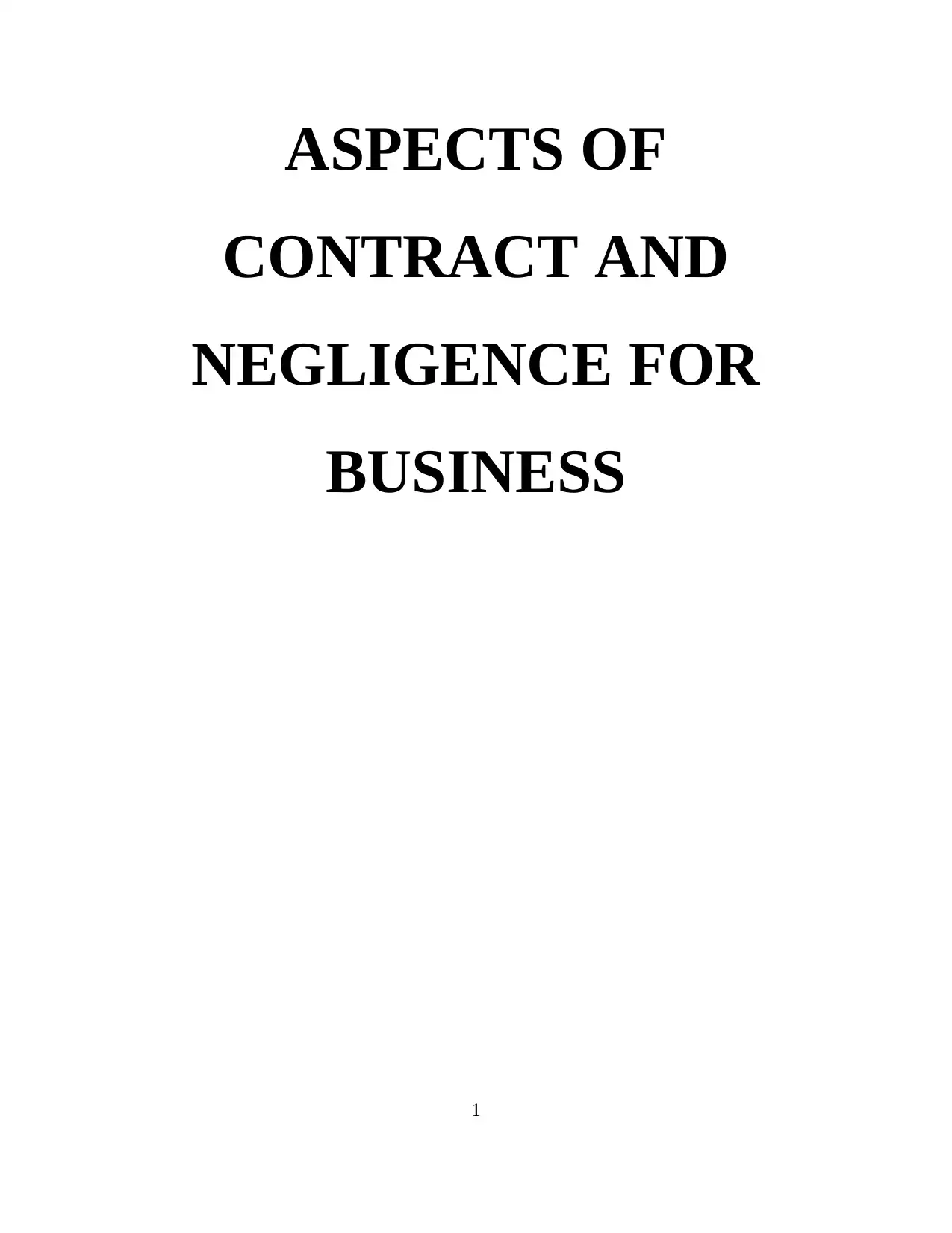
ASPECTS OF
CONTRACT AND
NEGLIGENCE FOR
BUSINESS
1
CONTRACT AND
NEGLIGENCE FOR
BUSINESS
1
Paraphrase This Document
Need a fresh take? Get an instant paraphrase of this document with our AI Paraphraser
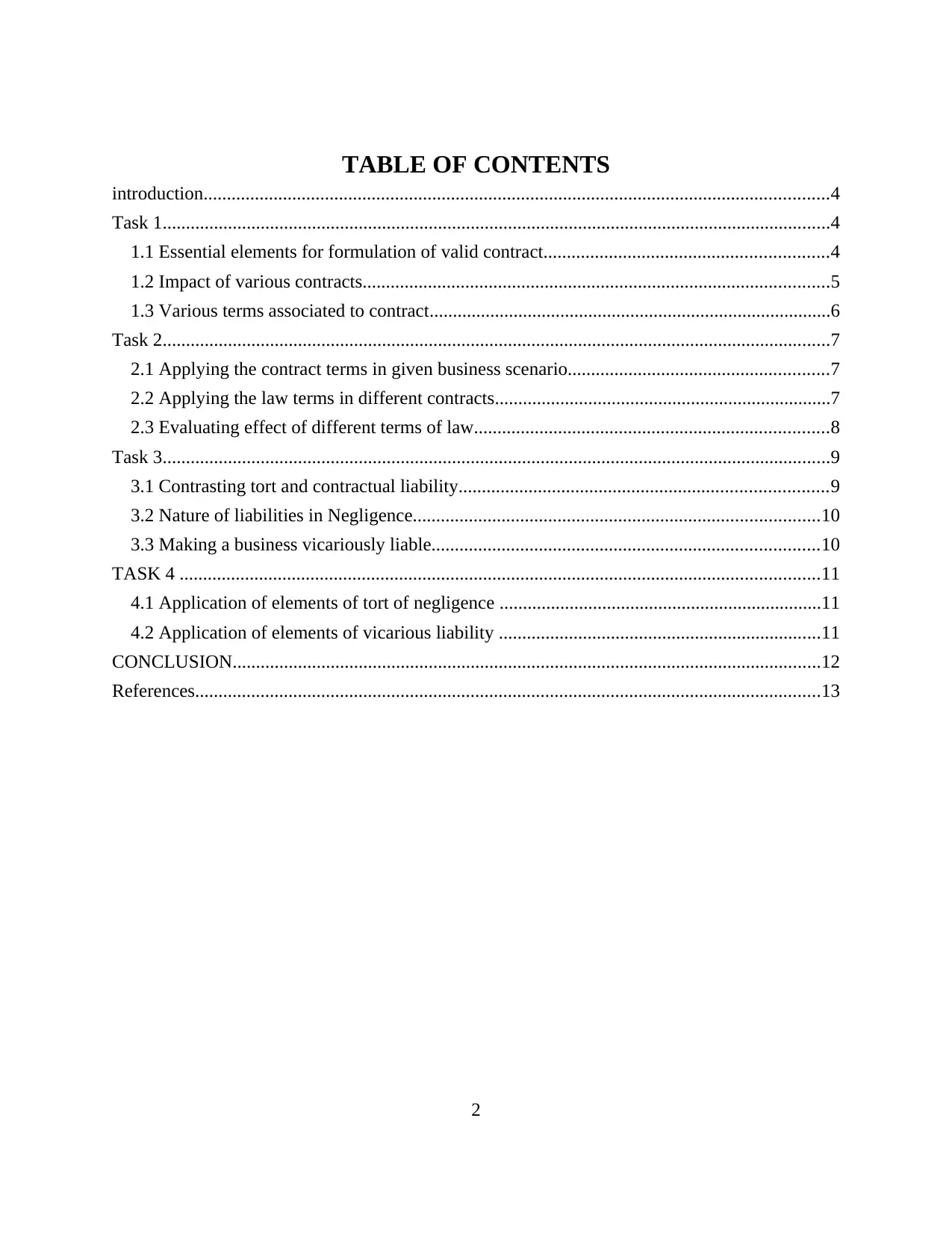
TABLE OF CONTENTS
introduction......................................................................................................................................4
Task 1...............................................................................................................................................4
1.1 Essential elements for formulation of valid contract.............................................................4
1.2 Impact of various contracts....................................................................................................5
1.3 Various terms associated to contract......................................................................................6
Task 2...............................................................................................................................................7
2.1 Applying the contract terms in given business scenario........................................................7
2.2 Applying the law terms in different contracts........................................................................7
2.3 Evaluating effect of different terms of law............................................................................8
Task 3...............................................................................................................................................9
3.1 Contrasting tort and contractual liability...............................................................................9
3.2 Nature of liabilities in Negligence.......................................................................................10
3.3 Making a business vicariously liable...................................................................................10
TASK 4 .........................................................................................................................................11
4.1 Application of elements of tort of negligence .....................................................................11
4.2 Application of elements of vicarious liability .....................................................................11
CONCLUSION..............................................................................................................................12
References......................................................................................................................................13
2
introduction......................................................................................................................................4
Task 1...............................................................................................................................................4
1.1 Essential elements for formulation of valid contract.............................................................4
1.2 Impact of various contracts....................................................................................................5
1.3 Various terms associated to contract......................................................................................6
Task 2...............................................................................................................................................7
2.1 Applying the contract terms in given business scenario........................................................7
2.2 Applying the law terms in different contracts........................................................................7
2.3 Evaluating effect of different terms of law............................................................................8
Task 3...............................................................................................................................................9
3.1 Contrasting tort and contractual liability...............................................................................9
3.2 Nature of liabilities in Negligence.......................................................................................10
3.3 Making a business vicariously liable...................................................................................10
TASK 4 .........................................................................................................................................11
4.1 Application of elements of tort of negligence .....................................................................11
4.2 Application of elements of vicarious liability .....................................................................11
CONCLUSION..............................................................................................................................12
References......................................................................................................................................13
2

3
⊘ This is a preview!⊘
Do you want full access?
Subscribe today to unlock all pages.

Trusted by 1+ million students worldwide
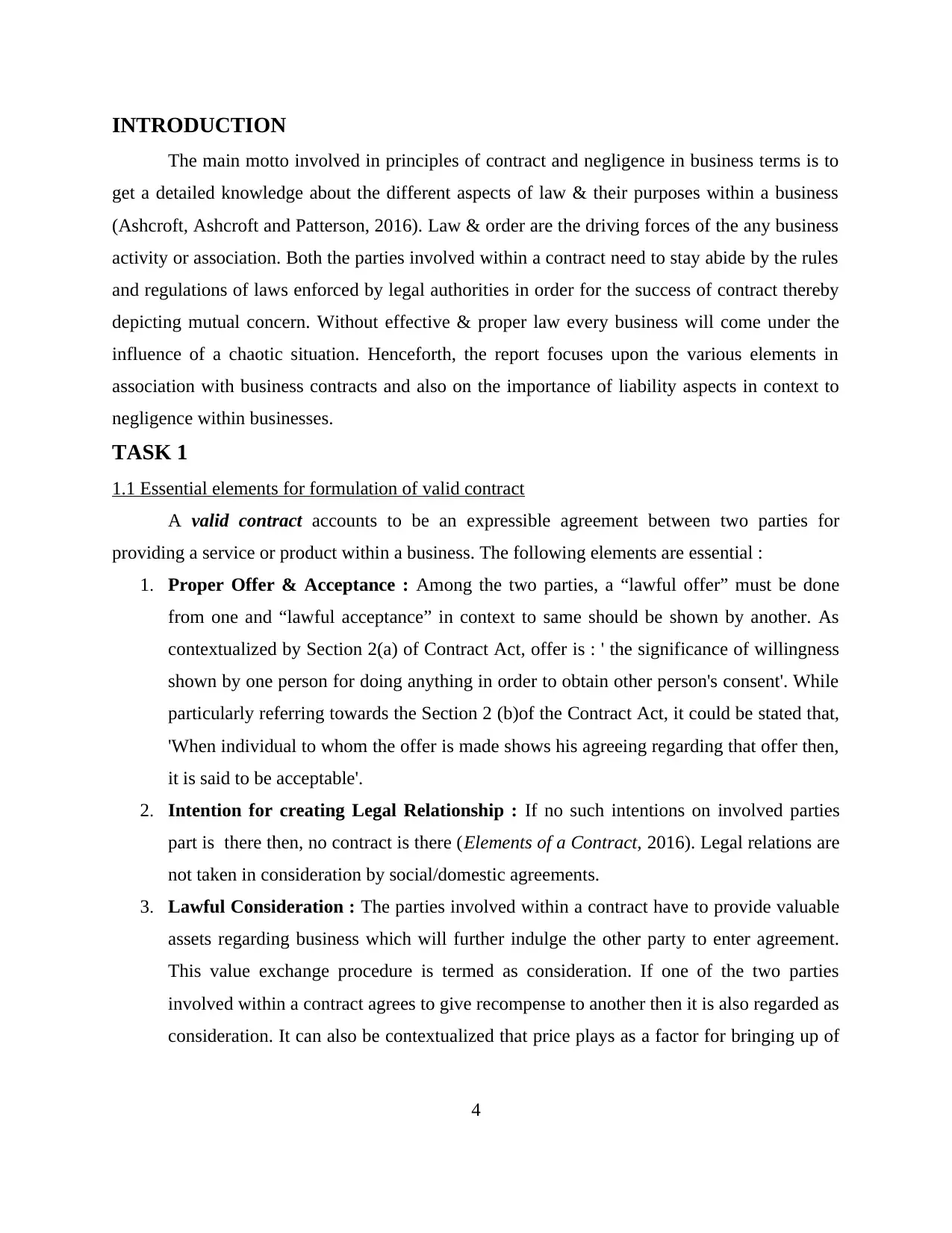
INTRODUCTION
The main motto involved in principles of contract and negligence in business terms is to
get a detailed knowledge about the different aspects of law & their purposes within a business
(Ashcroft, Ashcroft and Patterson, 2016). Law & order are the driving forces of the any business
activity or association. Both the parties involved within a contract need to stay abide by the rules
and regulations of laws enforced by legal authorities in order for the success of contract thereby
depicting mutual concern. Without effective & proper law every business will come under the
influence of a chaotic situation. Henceforth, the report focuses upon the various elements in
association with business contracts and also on the importance of liability aspects in context to
negligence within businesses.
TASK 1
1.1 Essential elements for formulation of valid contract
A valid contract accounts to be an expressible agreement between two parties for
providing a service or product within a business. The following elements are essential :
1. Proper Offer & Acceptance : Among the two parties, a “lawful offer” must be done
from one and “lawful acceptance” in context to same should be shown by another. As
contextualized by Section 2(a) of Contract Act, offer is : ' the significance of willingness
shown by one person for doing anything in order to obtain other person's consent'. While
particularly referring towards the Section 2 (b)of the Contract Act, it could be stated that,
'When individual to whom the offer is made shows his agreeing regarding that offer then,
it is said to be acceptable'.
2. Intention for creating Legal Relationship : If no such intentions on involved parties
part is there then, no contract is there (Elements of a Contract, 2016). Legal relations are
not taken in consideration by social/domestic agreements.
3. Lawful Consideration : The parties involved within a contract have to provide valuable
assets regarding business which will further indulge the other party to enter agreement.
This value exchange procedure is termed as consideration. If one of the two parties
involved within a contract agrees to give recompense to another then it is also regarded as
consideration. It can also be contextualized that price plays as a factor for bringing up of
4
The main motto involved in principles of contract and negligence in business terms is to
get a detailed knowledge about the different aspects of law & their purposes within a business
(Ashcroft, Ashcroft and Patterson, 2016). Law & order are the driving forces of the any business
activity or association. Both the parties involved within a contract need to stay abide by the rules
and regulations of laws enforced by legal authorities in order for the success of contract thereby
depicting mutual concern. Without effective & proper law every business will come under the
influence of a chaotic situation. Henceforth, the report focuses upon the various elements in
association with business contracts and also on the importance of liability aspects in context to
negligence within businesses.
TASK 1
1.1 Essential elements for formulation of valid contract
A valid contract accounts to be an expressible agreement between two parties for
providing a service or product within a business. The following elements are essential :
1. Proper Offer & Acceptance : Among the two parties, a “lawful offer” must be done
from one and “lawful acceptance” in context to same should be shown by another. As
contextualized by Section 2(a) of Contract Act, offer is : ' the significance of willingness
shown by one person for doing anything in order to obtain other person's consent'. While
particularly referring towards the Section 2 (b)of the Contract Act, it could be stated that,
'When individual to whom the offer is made shows his agreeing regarding that offer then,
it is said to be acceptable'.
2. Intention for creating Legal Relationship : If no such intentions on involved parties
part is there then, no contract is there (Elements of a Contract, 2016). Legal relations are
not taken in consideration by social/domestic agreements.
3. Lawful Consideration : The parties involved within a contract have to provide valuable
assets regarding business which will further indulge the other party to enter agreement.
This value exchange procedure is termed as consideration. If one of the two parties
involved within a contract agrees to give recompense to another then it is also regarded as
consideration. It can also be contextualized that price plays as a factor for bringing up of
4
Paraphrase This Document
Need a fresh take? Get an instant paraphrase of this document with our AI Paraphraser
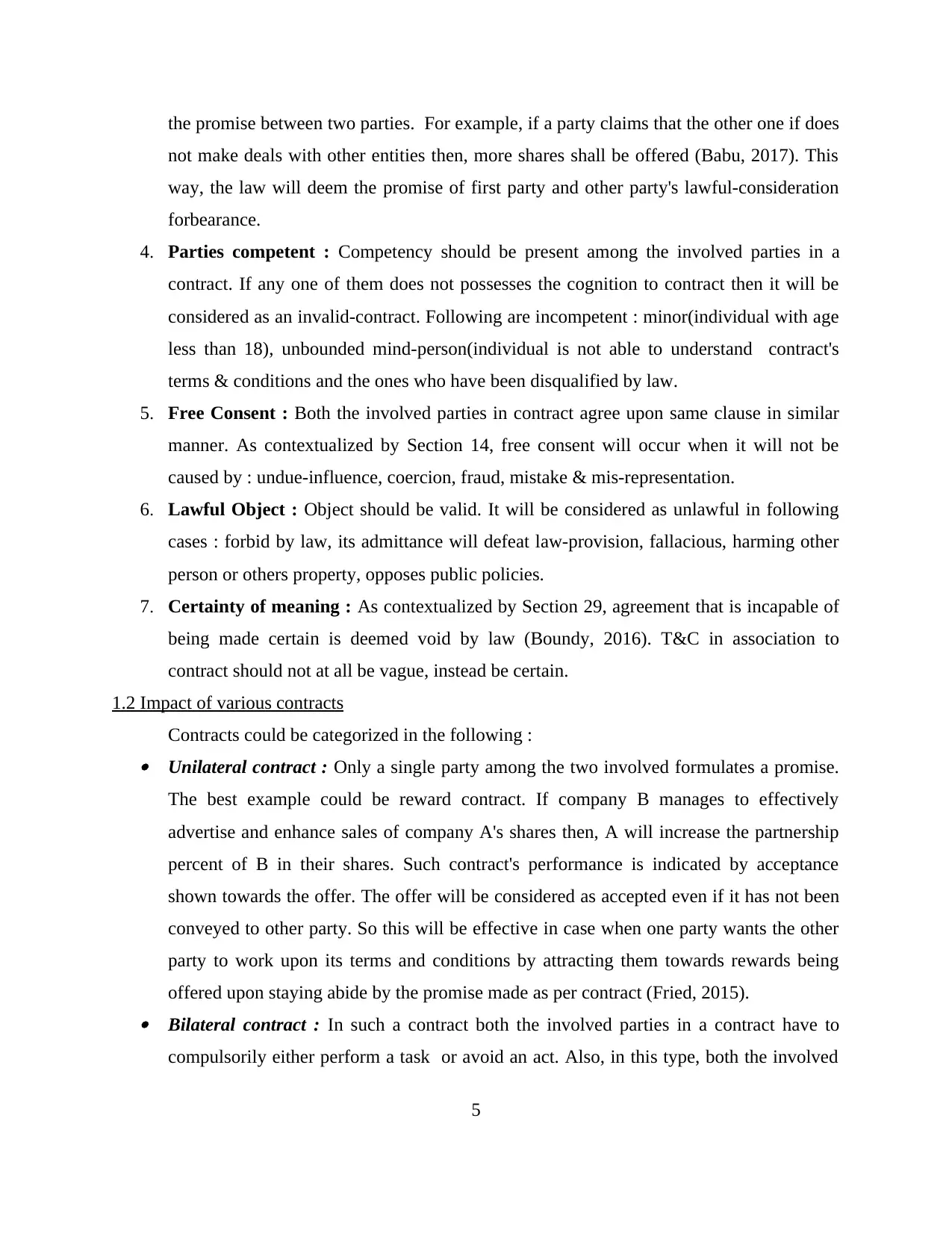
the promise between two parties. For example, if a party claims that the other one if does
not make deals with other entities then, more shares shall be offered (Babu, 2017). This
way, the law will deem the promise of first party and other party's lawful-consideration
forbearance.
4. Parties competent : Competency should be present among the involved parties in a
contract. If any one of them does not possesses the cognition to contract then it will be
considered as an invalid-contract. Following are incompetent : minor(individual with age
less than 18), unbounded mind-person(individual is not able to understand contract's
terms & conditions and the ones who have been disqualified by law.
5. Free Consent : Both the involved parties in contract agree upon same clause in similar
manner. As contextualized by Section 14, free consent will occur when it will not be
caused by : undue-influence, coercion, fraud, mistake & mis-representation.
6. Lawful Object : Object should be valid. It will be considered as unlawful in following
cases : forbid by law, its admittance will defeat law-provision, fallacious, harming other
person or others property, opposes public policies.
7. Certainty of meaning : As contextualized by Section 29, agreement that is incapable of
being made certain is deemed void by law (Boundy, 2016). T&C in association to
contract should not at all be vague, instead be certain.
1.2 Impact of various contracts
Contracts could be categorized in the following : Unilateral contract : Only a single party among the two involved formulates a promise.
The best example could be reward contract. If company B manages to effectively
advertise and enhance sales of company A's shares then, A will increase the partnership
percent of B in their shares. Such contract's performance is indicated by acceptance
shown towards the offer. The offer will be considered as accepted even if it has not been
conveyed to other party. So this will be effective in case when one party wants the other
party to work upon its terms and conditions by attracting them towards rewards being
offered upon staying abide by the promise made as per contract (Fried, 2015). Bilateral contract : In such a contract both the involved parties in a contract have to
compulsorily either perform a task or avoid an act. Also, in this type, both the involved
5
not make deals with other entities then, more shares shall be offered (Babu, 2017). This
way, the law will deem the promise of first party and other party's lawful-consideration
forbearance.
4. Parties competent : Competency should be present among the involved parties in a
contract. If any one of them does not possesses the cognition to contract then it will be
considered as an invalid-contract. Following are incompetent : minor(individual with age
less than 18), unbounded mind-person(individual is not able to understand contract's
terms & conditions and the ones who have been disqualified by law.
5. Free Consent : Both the involved parties in contract agree upon same clause in similar
manner. As contextualized by Section 14, free consent will occur when it will not be
caused by : undue-influence, coercion, fraud, mistake & mis-representation.
6. Lawful Object : Object should be valid. It will be considered as unlawful in following
cases : forbid by law, its admittance will defeat law-provision, fallacious, harming other
person or others property, opposes public policies.
7. Certainty of meaning : As contextualized by Section 29, agreement that is incapable of
being made certain is deemed void by law (Boundy, 2016). T&C in association to
contract should not at all be vague, instead be certain.
1.2 Impact of various contracts
Contracts could be categorized in the following : Unilateral contract : Only a single party among the two involved formulates a promise.
The best example could be reward contract. If company B manages to effectively
advertise and enhance sales of company A's shares then, A will increase the partnership
percent of B in their shares. Such contract's performance is indicated by acceptance
shown towards the offer. The offer will be considered as accepted even if it has not been
conveyed to other party. So this will be effective in case when one party wants the other
party to work upon its terms and conditions by attracting them towards rewards being
offered upon staying abide by the promise made as per contract (Fried, 2015). Bilateral contract : In such a contract both the involved parties in a contract have to
compulsorily either perform a task or avoid an act. Also, in this type, both the involved
5
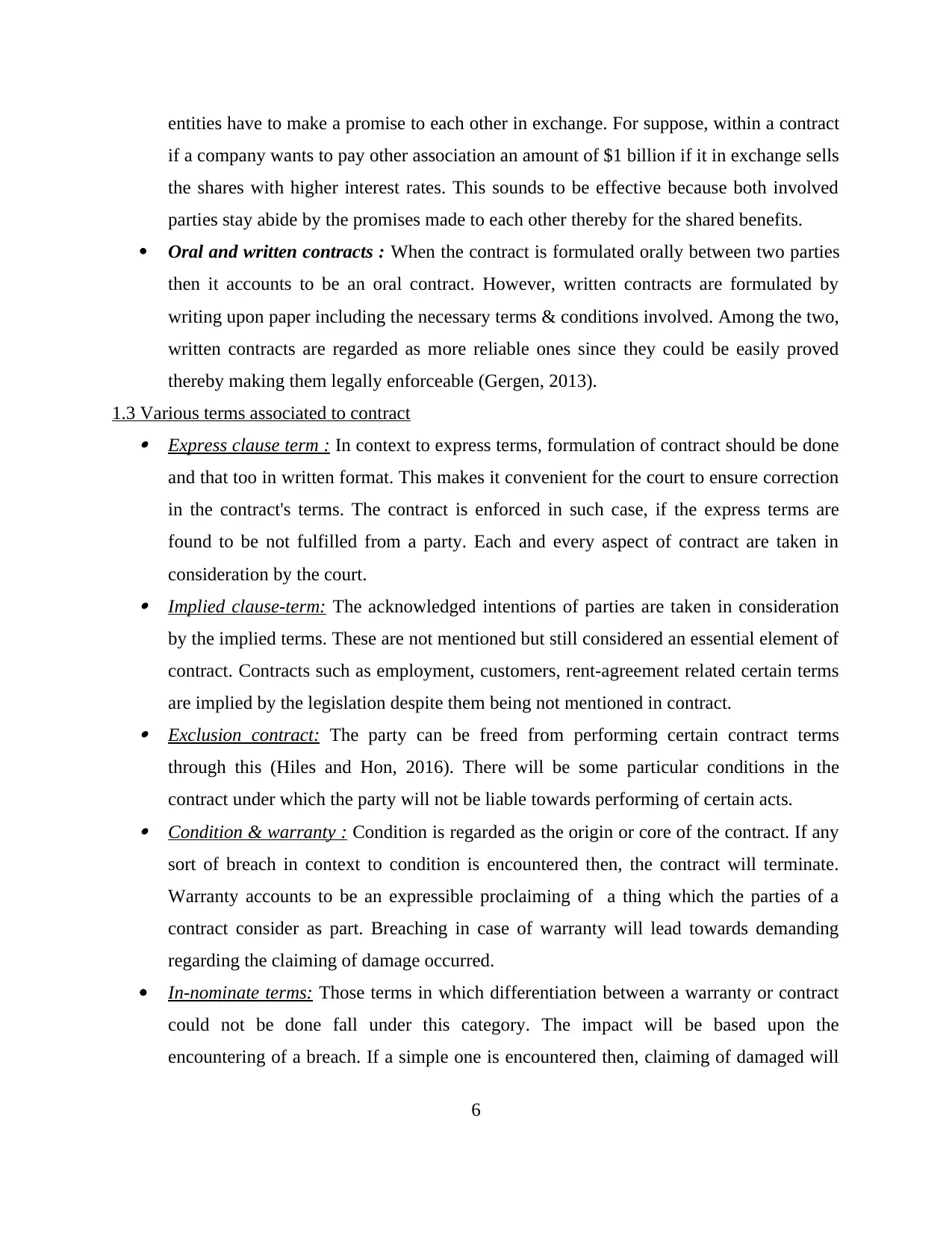
entities have to make a promise to each other in exchange. For suppose, within a contract
if a company wants to pay other association an amount of $1 billion if it in exchange sells
the shares with higher interest rates. This sounds to be effective because both involved
parties stay abide by the promises made to each other thereby for the shared benefits.
Oral and written contracts : When the contract is formulated orally between two parties
then it accounts to be an oral contract. However, written contracts are formulated by
writing upon paper including the necessary terms & conditions involved. Among the two,
written contracts are regarded as more reliable ones since they could be easily proved
thereby making them legally enforceable (Gergen, 2013).
1.3 Various terms associated to contract Express clause term : In context to express terms, formulation of contract should be done
and that too in written format. This makes it convenient for the court to ensure correction
in the contract's terms. The contract is enforced in such case, if the express terms are
found to be not fulfilled from a party. Each and every aspect of contract are taken in
consideration by the court. Implied clause-term: The acknowledged intentions of parties are taken in consideration
by the implied terms. These are not mentioned but still considered an essential element of
contract. Contracts such as employment, customers, rent-agreement related certain terms
are implied by the legislation despite them being not mentioned in contract. Exclusion contract: The party can be freed from performing certain contract terms
through this (Hiles and Hon, 2016). There will be some particular conditions in the
contract under which the party will not be liable towards performing of certain acts. Condition & warranty : Condition is regarded as the origin or core of the contract. If any
sort of breach in context to condition is encountered then, the contract will terminate.
Warranty accounts to be an expressible proclaiming of a thing which the parties of a
contract consider as part. Breaching in case of warranty will lead towards demanding
regarding the claiming of damage occurred.
In-nominate terms: Those terms in which differentiation between a warranty or contract
could not be done fall under this category. The impact will be based upon the
encountering of a breach. If a simple one is encountered then, claiming of damaged will
6
if a company wants to pay other association an amount of $1 billion if it in exchange sells
the shares with higher interest rates. This sounds to be effective because both involved
parties stay abide by the promises made to each other thereby for the shared benefits.
Oral and written contracts : When the contract is formulated orally between two parties
then it accounts to be an oral contract. However, written contracts are formulated by
writing upon paper including the necessary terms & conditions involved. Among the two,
written contracts are regarded as more reliable ones since they could be easily proved
thereby making them legally enforceable (Gergen, 2013).
1.3 Various terms associated to contract Express clause term : In context to express terms, formulation of contract should be done
and that too in written format. This makes it convenient for the court to ensure correction
in the contract's terms. The contract is enforced in such case, if the express terms are
found to be not fulfilled from a party. Each and every aspect of contract are taken in
consideration by the court. Implied clause-term: The acknowledged intentions of parties are taken in consideration
by the implied terms. These are not mentioned but still considered an essential element of
contract. Contracts such as employment, customers, rent-agreement related certain terms
are implied by the legislation despite them being not mentioned in contract. Exclusion contract: The party can be freed from performing certain contract terms
through this (Hiles and Hon, 2016). There will be some particular conditions in the
contract under which the party will not be liable towards performing of certain acts. Condition & warranty : Condition is regarded as the origin or core of the contract. If any
sort of breach in context to condition is encountered then, the contract will terminate.
Warranty accounts to be an expressible proclaiming of a thing which the parties of a
contract consider as part. Breaching in case of warranty will lead towards demanding
regarding the claiming of damage occurred.
In-nominate terms: Those terms in which differentiation between a warranty or contract
could not be done fall under this category. The impact will be based upon the
encountering of a breach. If a simple one is encountered then, claiming of damaged will
6
⊘ This is a preview!⊘
Do you want full access?
Subscribe today to unlock all pages.

Trusted by 1+ million students worldwide
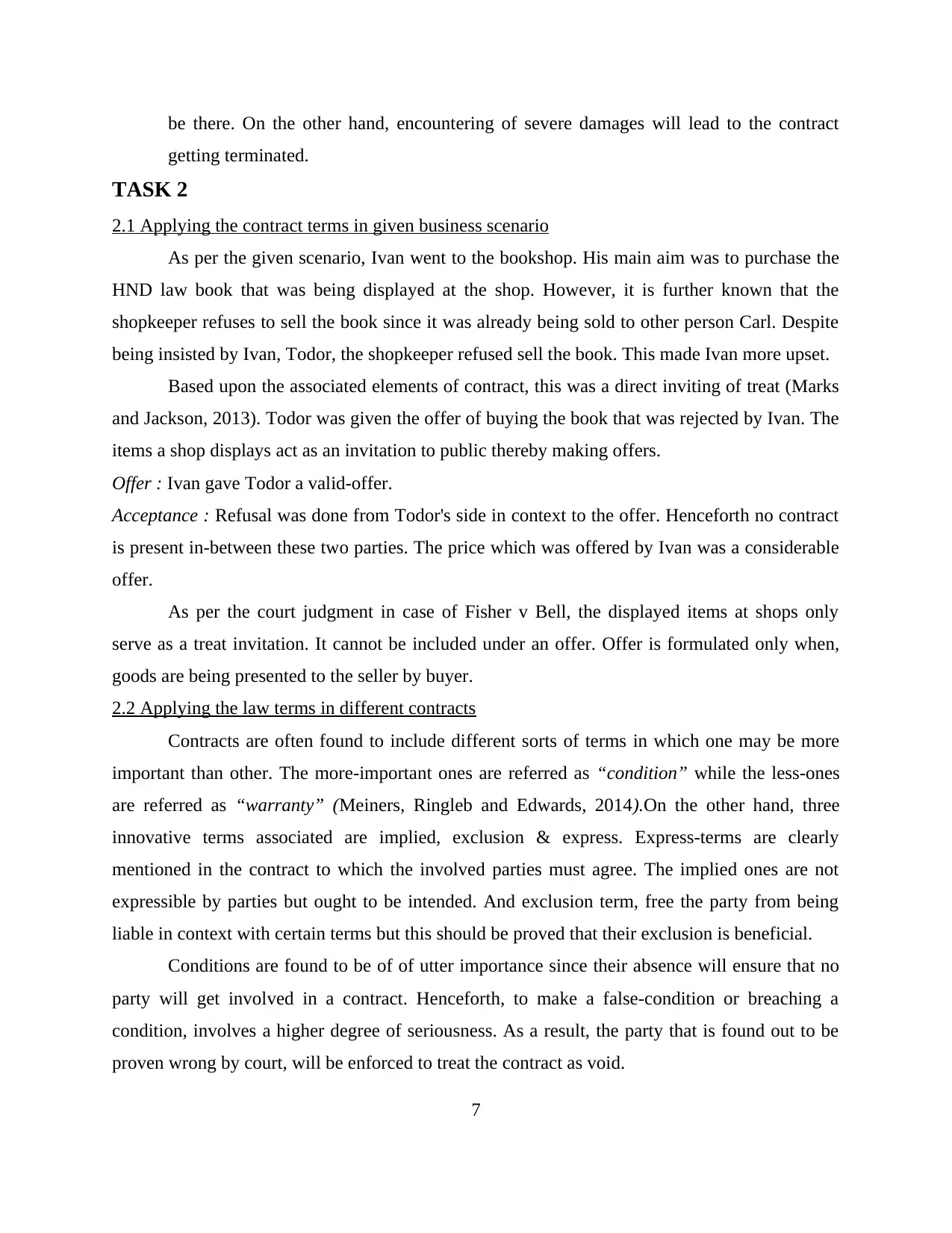
be there. On the other hand, encountering of severe damages will lead to the contract
getting terminated.
TASK 2
2.1 Applying the contract terms in given business scenario
As per the given scenario, Ivan went to the bookshop. His main aim was to purchase the
HND law book that was being displayed at the shop. However, it is further known that the
shopkeeper refuses to sell the book since it was already being sold to other person Carl. Despite
being insisted by Ivan, Todor, the shopkeeper refused sell the book. This made Ivan more upset.
Based upon the associated elements of contract, this was a direct inviting of treat (Marks
and Jackson, 2013). Todor was given the offer of buying the book that was rejected by Ivan. The
items a shop displays act as an invitation to public thereby making offers.
Offer : Ivan gave Todor a valid-offer.
Acceptance : Refusal was done from Todor's side in context to the offer. Henceforth no contract
is present in-between these two parties. The price which was offered by Ivan was a considerable
offer.
As per the court judgment in case of Fisher v Bell, the displayed items at shops only
serve as a treat invitation. It cannot be included under an offer. Offer is formulated only when,
goods are being presented to the seller by buyer.
2.2 Applying the law terms in different contracts
Contracts are often found to include different sorts of terms in which one may be more
important than other. The more-important ones are referred as “condition” while the less-ones
are referred as “warranty” (Meiners, Ringleb and Edwards, 2014).On the other hand, three
innovative terms associated are implied, exclusion & express. Express-terms are clearly
mentioned in the contract to which the involved parties must agree. The implied ones are not
expressible by parties but ought to be intended. And exclusion term, free the party from being
liable in context with certain terms but this should be proved that their exclusion is beneficial.
Conditions are found to be of of utter importance since their absence will ensure that no
party will get involved in a contract. Henceforth, to make a false-condition or breaching a
condition, involves a higher degree of seriousness. As a result, the party that is found out to be
proven wrong by court, will be enforced to treat the contract as void.
7
getting terminated.
TASK 2
2.1 Applying the contract terms in given business scenario
As per the given scenario, Ivan went to the bookshop. His main aim was to purchase the
HND law book that was being displayed at the shop. However, it is further known that the
shopkeeper refuses to sell the book since it was already being sold to other person Carl. Despite
being insisted by Ivan, Todor, the shopkeeper refused sell the book. This made Ivan more upset.
Based upon the associated elements of contract, this was a direct inviting of treat (Marks
and Jackson, 2013). Todor was given the offer of buying the book that was rejected by Ivan. The
items a shop displays act as an invitation to public thereby making offers.
Offer : Ivan gave Todor a valid-offer.
Acceptance : Refusal was done from Todor's side in context to the offer. Henceforth no contract
is present in-between these two parties. The price which was offered by Ivan was a considerable
offer.
As per the court judgment in case of Fisher v Bell, the displayed items at shops only
serve as a treat invitation. It cannot be included under an offer. Offer is formulated only when,
goods are being presented to the seller by buyer.
2.2 Applying the law terms in different contracts
Contracts are often found to include different sorts of terms in which one may be more
important than other. The more-important ones are referred as “condition” while the less-ones
are referred as “warranty” (Meiners, Ringleb and Edwards, 2014).On the other hand, three
innovative terms associated are implied, exclusion & express. Express-terms are clearly
mentioned in the contract to which the involved parties must agree. The implied ones are not
expressible by parties but ought to be intended. And exclusion term, free the party from being
liable in context with certain terms but this should be proved that their exclusion is beneficial.
Conditions are found to be of of utter importance since their absence will ensure that no
party will get involved in a contract. Henceforth, to make a false-condition or breaching a
condition, involves a higher degree of seriousness. As a result, the party that is found out to be
proven wrong by court, will be enforced to treat the contract as void.
7
Paraphrase This Document
Need a fresh take? Get an instant paraphrase of this document with our AI Paraphraser
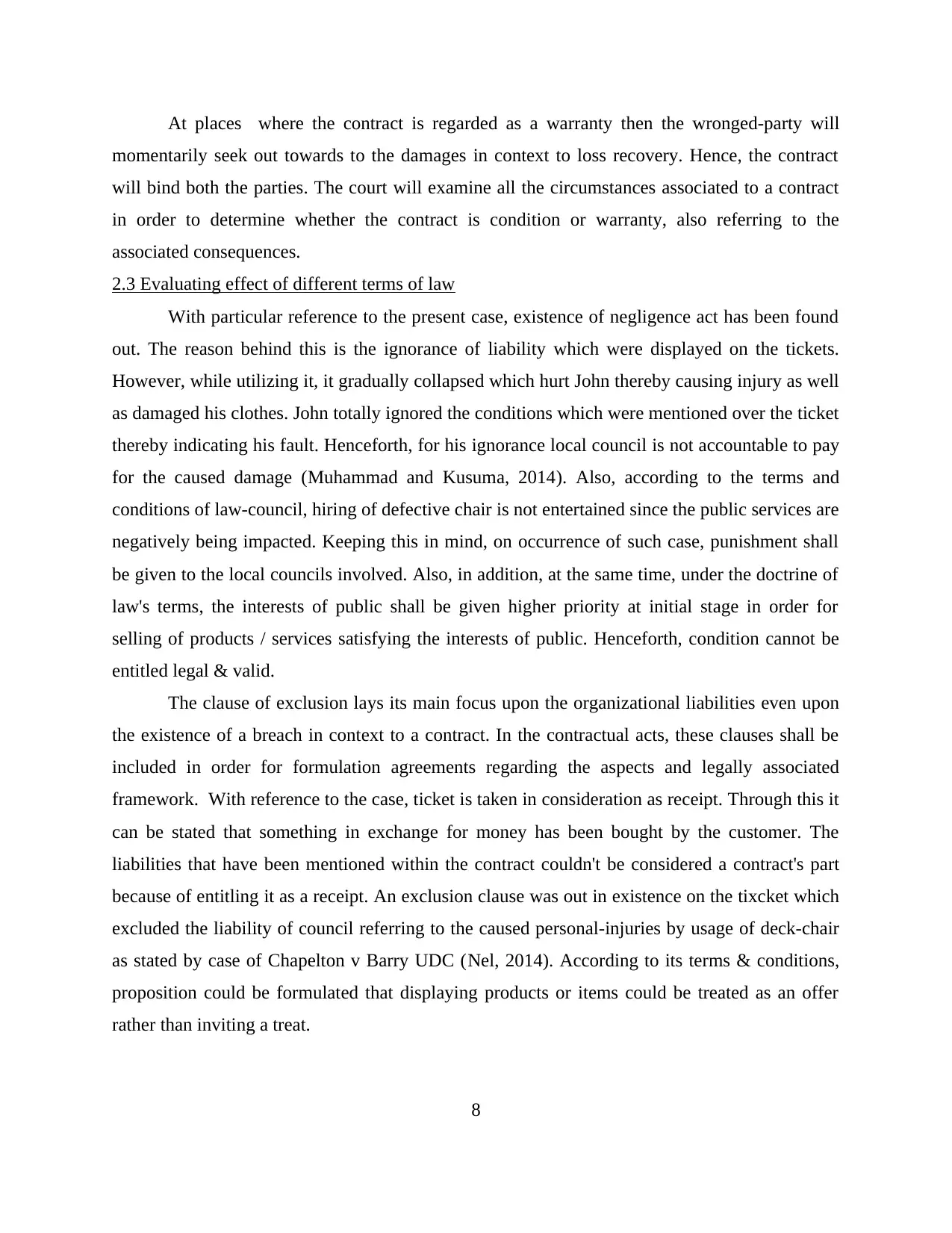
At places where the contract is regarded as a warranty then the wronged-party will
momentarily seek out towards to the damages in context to loss recovery. Hence, the contract
will bind both the parties. The court will examine all the circumstances associated to a contract
in order to determine whether the contract is condition or warranty, also referring to the
associated consequences.
2.3 Evaluating effect of different terms of law
With particular reference to the present case, existence of negligence act has been found
out. The reason behind this is the ignorance of liability which were displayed on the tickets.
However, while utilizing it, it gradually collapsed which hurt John thereby causing injury as well
as damaged his clothes. John totally ignored the conditions which were mentioned over the ticket
thereby indicating his fault. Henceforth, for his ignorance local council is not accountable to pay
for the caused damage (Muhammad and Kusuma, 2014). Also, according to the terms and
conditions of law-council, hiring of defective chair is not entertained since the public services are
negatively being impacted. Keeping this in mind, on occurrence of such case, punishment shall
be given to the local councils involved. Also, in addition, at the same time, under the doctrine of
law's terms, the interests of public shall be given higher priority at initial stage in order for
selling of products / services satisfying the interests of public. Henceforth, condition cannot be
entitled legal & valid.
The clause of exclusion lays its main focus upon the organizational liabilities even upon
the existence of a breach in context to a contract. In the contractual acts, these clauses shall be
included in order for formulation agreements regarding the aspects and legally associated
framework. With reference to the case, ticket is taken in consideration as receipt. Through this it
can be stated that something in exchange for money has been bought by the customer. The
liabilities that have been mentioned within the contract couldn't be considered a contract's part
because of entitling it as a receipt. An exclusion clause was out in existence on the tixcket which
excluded the liability of council referring to the caused personal-injuries by usage of deck-chair
as stated by case of Chapelton v Barry UDC (Nel, 2014). According to its terms & conditions,
proposition could be formulated that displaying products or items could be treated as an offer
rather than inviting a treat.
8
momentarily seek out towards to the damages in context to loss recovery. Hence, the contract
will bind both the parties. The court will examine all the circumstances associated to a contract
in order to determine whether the contract is condition or warranty, also referring to the
associated consequences.
2.3 Evaluating effect of different terms of law
With particular reference to the present case, existence of negligence act has been found
out. The reason behind this is the ignorance of liability which were displayed on the tickets.
However, while utilizing it, it gradually collapsed which hurt John thereby causing injury as well
as damaged his clothes. John totally ignored the conditions which were mentioned over the ticket
thereby indicating his fault. Henceforth, for his ignorance local council is not accountable to pay
for the caused damage (Muhammad and Kusuma, 2014). Also, according to the terms and
conditions of law-council, hiring of defective chair is not entertained since the public services are
negatively being impacted. Keeping this in mind, on occurrence of such case, punishment shall
be given to the local councils involved. Also, in addition, at the same time, under the doctrine of
law's terms, the interests of public shall be given higher priority at initial stage in order for
selling of products / services satisfying the interests of public. Henceforth, condition cannot be
entitled legal & valid.
The clause of exclusion lays its main focus upon the organizational liabilities even upon
the existence of a breach in context to a contract. In the contractual acts, these clauses shall be
included in order for formulation agreements regarding the aspects and legally associated
framework. With reference to the case, ticket is taken in consideration as receipt. Through this it
can be stated that something in exchange for money has been bought by the customer. The
liabilities that have been mentioned within the contract couldn't be considered a contract's part
because of entitling it as a receipt. An exclusion clause was out in existence on the tixcket which
excluded the liability of council referring to the caused personal-injuries by usage of deck-chair
as stated by case of Chapelton v Barry UDC (Nel, 2014). According to its terms & conditions,
proposition could be formulated that displaying products or items could be treated as an offer
rather than inviting a treat.
8
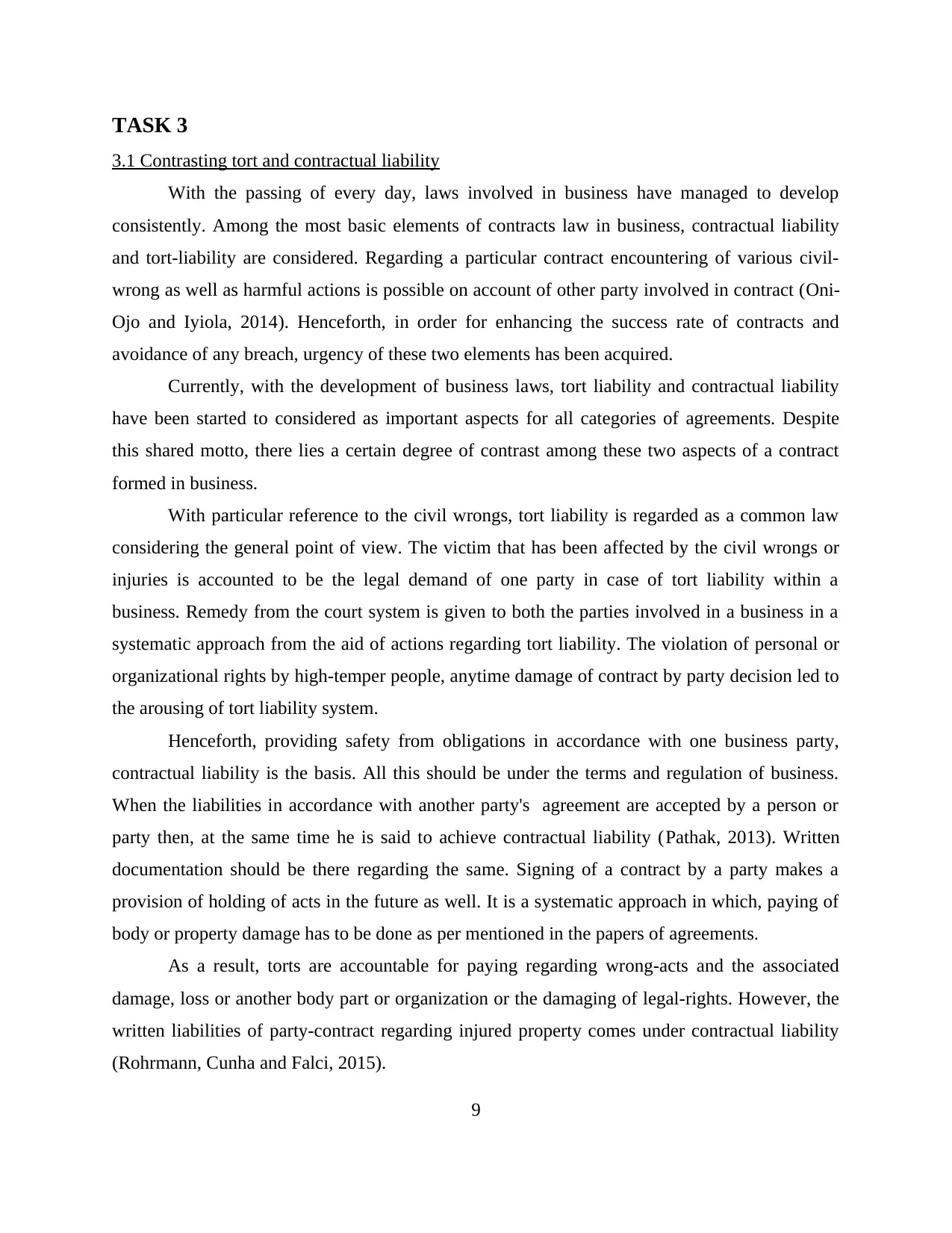
TASK 3
3.1 Contrasting tort and contractual liability
With the passing of every day, laws involved in business have managed to develop
consistently. Among the most basic elements of contracts law in business, contractual liability
and tort-liability are considered. Regarding a particular contract encountering of various civil-
wrong as well as harmful actions is possible on account of other party involved in contract (Oni-
Ojo and Iyiola, 2014). Henceforth, in order for enhancing the success rate of contracts and
avoidance of any breach, urgency of these two elements has been acquired.
Currently, with the development of business laws, tort liability and contractual liability
have been started to considered as important aspects for all categories of agreements. Despite
this shared motto, there lies a certain degree of contrast among these two aspects of a contract
formed in business.
With particular reference to the civil wrongs, tort liability is regarded as a common law
considering the general point of view. The victim that has been affected by the civil wrongs or
injuries is accounted to be the legal demand of one party in case of tort liability within a
business. Remedy from the court system is given to both the parties involved in a business in a
systematic approach from the aid of actions regarding tort liability. The violation of personal or
organizational rights by high-temper people, anytime damage of contract by party decision led to
the arousing of tort liability system.
Henceforth, providing safety from obligations in accordance with one business party,
contractual liability is the basis. All this should be under the terms and regulation of business.
When the liabilities in accordance with another party's agreement are accepted by a person or
party then, at the same time he is said to achieve contractual liability (Pathak, 2013). Written
documentation should be there regarding the same. Signing of a contract by a party makes a
provision of holding of acts in the future as well. It is a systematic approach in which, paying of
body or property damage has to be done as per mentioned in the papers of agreements.
As a result, torts are accountable for paying regarding wrong-acts and the associated
damage, loss or another body part or organization or the damaging of legal-rights. However, the
written liabilities of party-contract regarding injured property comes under contractual liability
(Rohrmann, Cunha and Falci, 2015).
9
3.1 Contrasting tort and contractual liability
With the passing of every day, laws involved in business have managed to develop
consistently. Among the most basic elements of contracts law in business, contractual liability
and tort-liability are considered. Regarding a particular contract encountering of various civil-
wrong as well as harmful actions is possible on account of other party involved in contract (Oni-
Ojo and Iyiola, 2014). Henceforth, in order for enhancing the success rate of contracts and
avoidance of any breach, urgency of these two elements has been acquired.
Currently, with the development of business laws, tort liability and contractual liability
have been started to considered as important aspects for all categories of agreements. Despite
this shared motto, there lies a certain degree of contrast among these two aspects of a contract
formed in business.
With particular reference to the civil wrongs, tort liability is regarded as a common law
considering the general point of view. The victim that has been affected by the civil wrongs or
injuries is accounted to be the legal demand of one party in case of tort liability within a
business. Remedy from the court system is given to both the parties involved in a business in a
systematic approach from the aid of actions regarding tort liability. The violation of personal or
organizational rights by high-temper people, anytime damage of contract by party decision led to
the arousing of tort liability system.
Henceforth, providing safety from obligations in accordance with one business party,
contractual liability is the basis. All this should be under the terms and regulation of business.
When the liabilities in accordance with another party's agreement are accepted by a person or
party then, at the same time he is said to achieve contractual liability (Pathak, 2013). Written
documentation should be there regarding the same. Signing of a contract by a party makes a
provision of holding of acts in the future as well. It is a systematic approach in which, paying of
body or property damage has to be done as per mentioned in the papers of agreements.
As a result, torts are accountable for paying regarding wrong-acts and the associated
damage, loss or another body part or organization or the damaging of legal-rights. However, the
written liabilities of party-contract regarding injured property comes under contractual liability
(Rohrmann, Cunha and Falci, 2015).
9
⊘ This is a preview!⊘
Do you want full access?
Subscribe today to unlock all pages.

Trusted by 1+ million students worldwide
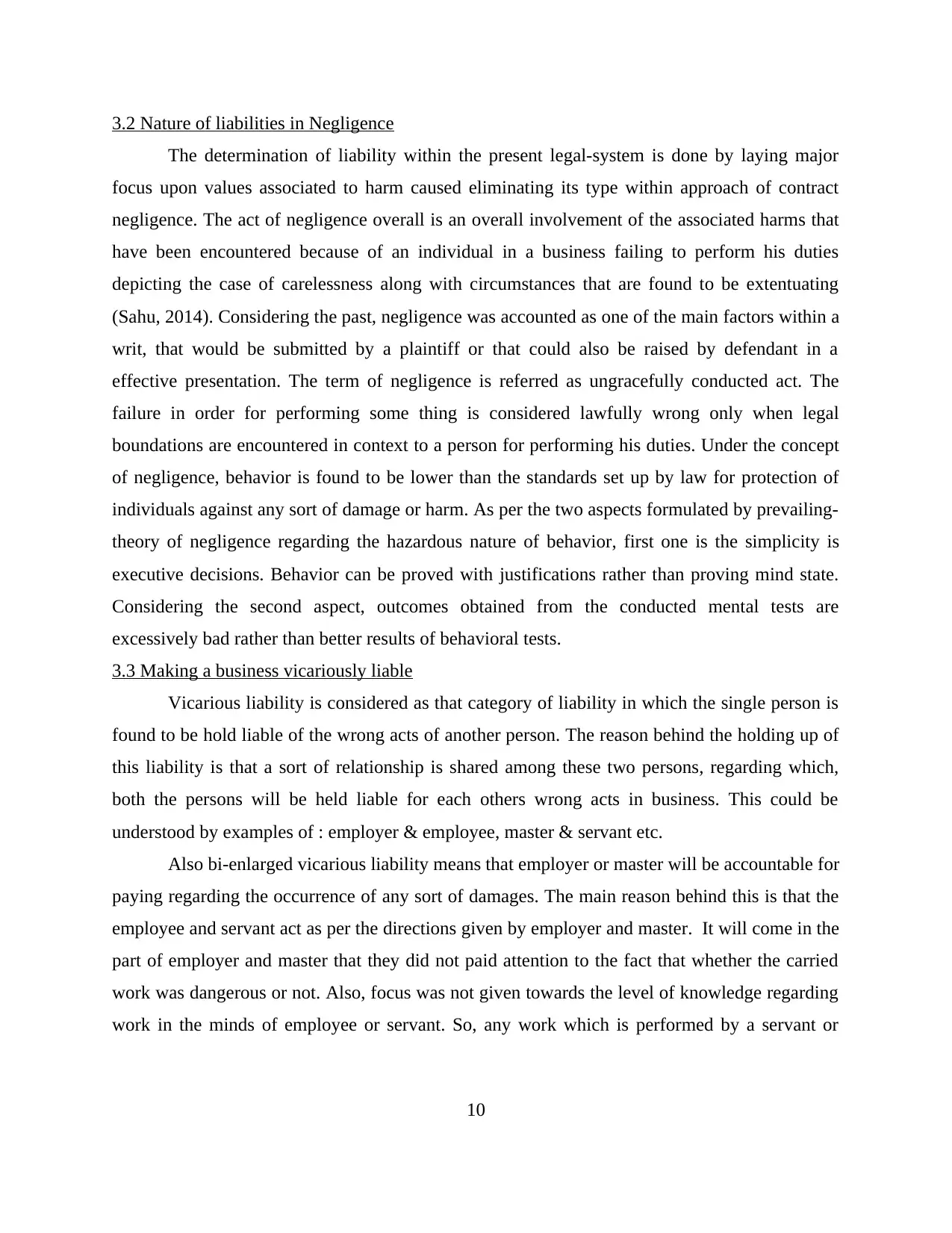
3.2 Nature of liabilities in Negligence
The determination of liability within the present legal-system is done by laying major
focus upon values associated to harm caused eliminating its type within approach of contract
negligence. The act of negligence overall is an overall involvement of the associated harms that
have been encountered because of an individual in a business failing to perform his duties
depicting the case of carelessness along with circumstances that are found to be extentuating
(Sahu, 2014). Considering the past, negligence was accounted as one of the main factors within a
writ, that would be submitted by a plaintiff or that could also be raised by defendant in a
effective presentation. The term of negligence is referred as ungracefully conducted act. The
failure in order for performing some thing is considered lawfully wrong only when legal
boundations are encountered in context to a person for performing his duties. Under the concept
of negligence, behavior is found to be lower than the standards set up by law for protection of
individuals against any sort of damage or harm. As per the two aspects formulated by prevailing-
theory of negligence regarding the hazardous nature of behavior, first one is the simplicity is
executive decisions. Behavior can be proved with justifications rather than proving mind state.
Considering the second aspect, outcomes obtained from the conducted mental tests are
excessively bad rather than better results of behavioral tests.
3.3 Making a business vicariously liable
Vicarious liability is considered as that category of liability in which the single person is
found to be hold liable of the wrong acts of another person. The reason behind the holding up of
this liability is that a sort of relationship is shared among these two persons, regarding which,
both the persons will be held liable for each others wrong acts in business. This could be
understood by examples of : employer & employee, master & servant etc.
Also bi-enlarged vicarious liability means that employer or master will be accountable for
paying regarding the occurrence of any sort of damages. The main reason behind this is that the
employee and servant act as per the directions given by employer and master. It will come in the
part of employer and master that they did not paid attention to the fact that whether the carried
work was dangerous or not. Also, focus was not given towards the level of knowledge regarding
work in the minds of employee or servant. So, any work which is performed by a servant or
10
The determination of liability within the present legal-system is done by laying major
focus upon values associated to harm caused eliminating its type within approach of contract
negligence. The act of negligence overall is an overall involvement of the associated harms that
have been encountered because of an individual in a business failing to perform his duties
depicting the case of carelessness along with circumstances that are found to be extentuating
(Sahu, 2014). Considering the past, negligence was accounted as one of the main factors within a
writ, that would be submitted by a plaintiff or that could also be raised by defendant in a
effective presentation. The term of negligence is referred as ungracefully conducted act. The
failure in order for performing some thing is considered lawfully wrong only when legal
boundations are encountered in context to a person for performing his duties. Under the concept
of negligence, behavior is found to be lower than the standards set up by law for protection of
individuals against any sort of damage or harm. As per the two aspects formulated by prevailing-
theory of negligence regarding the hazardous nature of behavior, first one is the simplicity is
executive decisions. Behavior can be proved with justifications rather than proving mind state.
Considering the second aspect, outcomes obtained from the conducted mental tests are
excessively bad rather than better results of behavioral tests.
3.3 Making a business vicariously liable
Vicarious liability is considered as that category of liability in which the single person is
found to be hold liable of the wrong acts of another person. The reason behind the holding up of
this liability is that a sort of relationship is shared among these two persons, regarding which,
both the persons will be held liable for each others wrong acts in business. This could be
understood by examples of : employer & employee, master & servant etc.
Also bi-enlarged vicarious liability means that employer or master will be accountable for
paying regarding the occurrence of any sort of damages. The main reason behind this is that the
employee and servant act as per the directions given by employer and master. It will come in the
part of employer and master that they did not paid attention to the fact that whether the carried
work was dangerous or not. Also, focus was not given towards the level of knowledge regarding
work in the minds of employee or servant. So, any work which is performed by a servant or
10
Paraphrase This Document
Need a fresh take? Get an instant paraphrase of this document with our AI Paraphraser
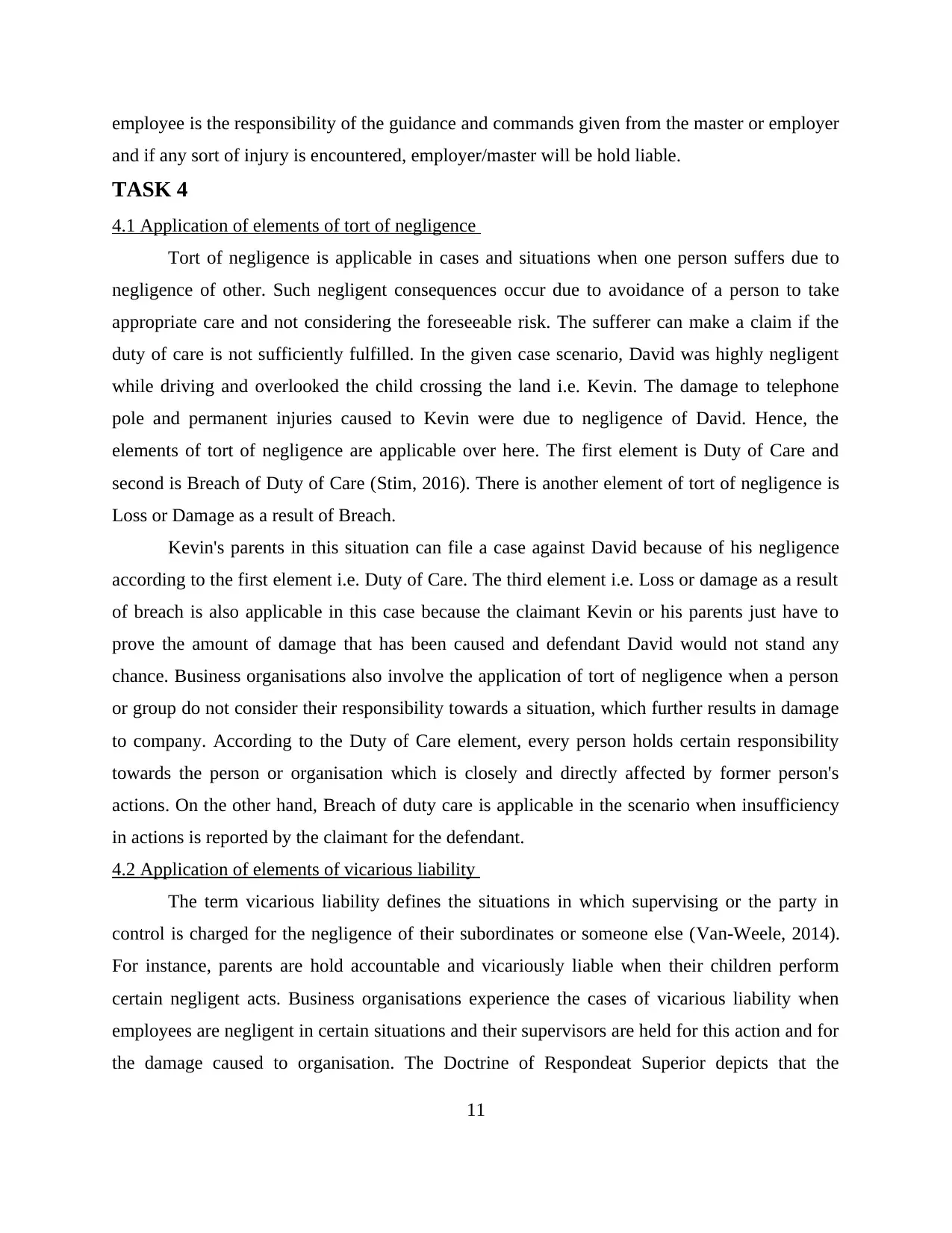
employee is the responsibility of the guidance and commands given from the master or employer
and if any sort of injury is encountered, employer/master will be hold liable.
TASK 4
4.1 Application of elements of tort of negligence
Tort of negligence is applicable in cases and situations when one person suffers due to
negligence of other. Such negligent consequences occur due to avoidance of a person to take
appropriate care and not considering the foreseeable risk. The sufferer can make a claim if the
duty of care is not sufficiently fulfilled. In the given case scenario, David was highly negligent
while driving and overlooked the child crossing the land i.e. Kevin. The damage to telephone
pole and permanent injuries caused to Kevin were due to negligence of David. Hence, the
elements of tort of negligence are applicable over here. The first element is Duty of Care and
second is Breach of Duty of Care (Stim, 2016). There is another element of tort of negligence is
Loss or Damage as a result of Breach.
Kevin's parents in this situation can file a case against David because of his negligence
according to the first element i.e. Duty of Care. The third element i.e. Loss or damage as a result
of breach is also applicable in this case because the claimant Kevin or his parents just have to
prove the amount of damage that has been caused and defendant David would not stand any
chance. Business organisations also involve the application of tort of negligence when a person
or group do not consider their responsibility towards a situation, which further results in damage
to company. According to the Duty of Care element, every person holds certain responsibility
towards the person or organisation which is closely and directly affected by former person's
actions. On the other hand, Breach of duty care is applicable in the scenario when insufficiency
in actions is reported by the claimant for the defendant.
4.2 Application of elements of vicarious liability
The term vicarious liability defines the situations in which supervising or the party in
control is charged for the negligence of their subordinates or someone else (Van-Weele, 2014).
For instance, parents are hold accountable and vicariously liable when their children perform
certain negligent acts. Business organisations experience the cases of vicarious liability when
employees are negligent in certain situations and their supervisors are held for this action and for
the damage caused to organisation. The Doctrine of Respondeat Superior depicts that the
11
and if any sort of injury is encountered, employer/master will be hold liable.
TASK 4
4.1 Application of elements of tort of negligence
Tort of negligence is applicable in cases and situations when one person suffers due to
negligence of other. Such negligent consequences occur due to avoidance of a person to take
appropriate care and not considering the foreseeable risk. The sufferer can make a claim if the
duty of care is not sufficiently fulfilled. In the given case scenario, David was highly negligent
while driving and overlooked the child crossing the land i.e. Kevin. The damage to telephone
pole and permanent injuries caused to Kevin were due to negligence of David. Hence, the
elements of tort of negligence are applicable over here. The first element is Duty of Care and
second is Breach of Duty of Care (Stim, 2016). There is another element of tort of negligence is
Loss or Damage as a result of Breach.
Kevin's parents in this situation can file a case against David because of his negligence
according to the first element i.e. Duty of Care. The third element i.e. Loss or damage as a result
of breach is also applicable in this case because the claimant Kevin or his parents just have to
prove the amount of damage that has been caused and defendant David would not stand any
chance. Business organisations also involve the application of tort of negligence when a person
or group do not consider their responsibility towards a situation, which further results in damage
to company. According to the Duty of Care element, every person holds certain responsibility
towards the person or organisation which is closely and directly affected by former person's
actions. On the other hand, Breach of duty care is applicable in the scenario when insufficiency
in actions is reported by the claimant for the defendant.
4.2 Application of elements of vicarious liability
The term vicarious liability defines the situations in which supervising or the party in
control is charged for the negligence of their subordinates or someone else (Van-Weele, 2014).
For instance, parents are hold accountable and vicariously liable when their children perform
certain negligent acts. Business organisations experience the cases of vicarious liability when
employees are negligent in certain situations and their supervisors are held for this action and for
the damage caused to organisation. The Doctrine of Respondeat Superior depicts that the
11
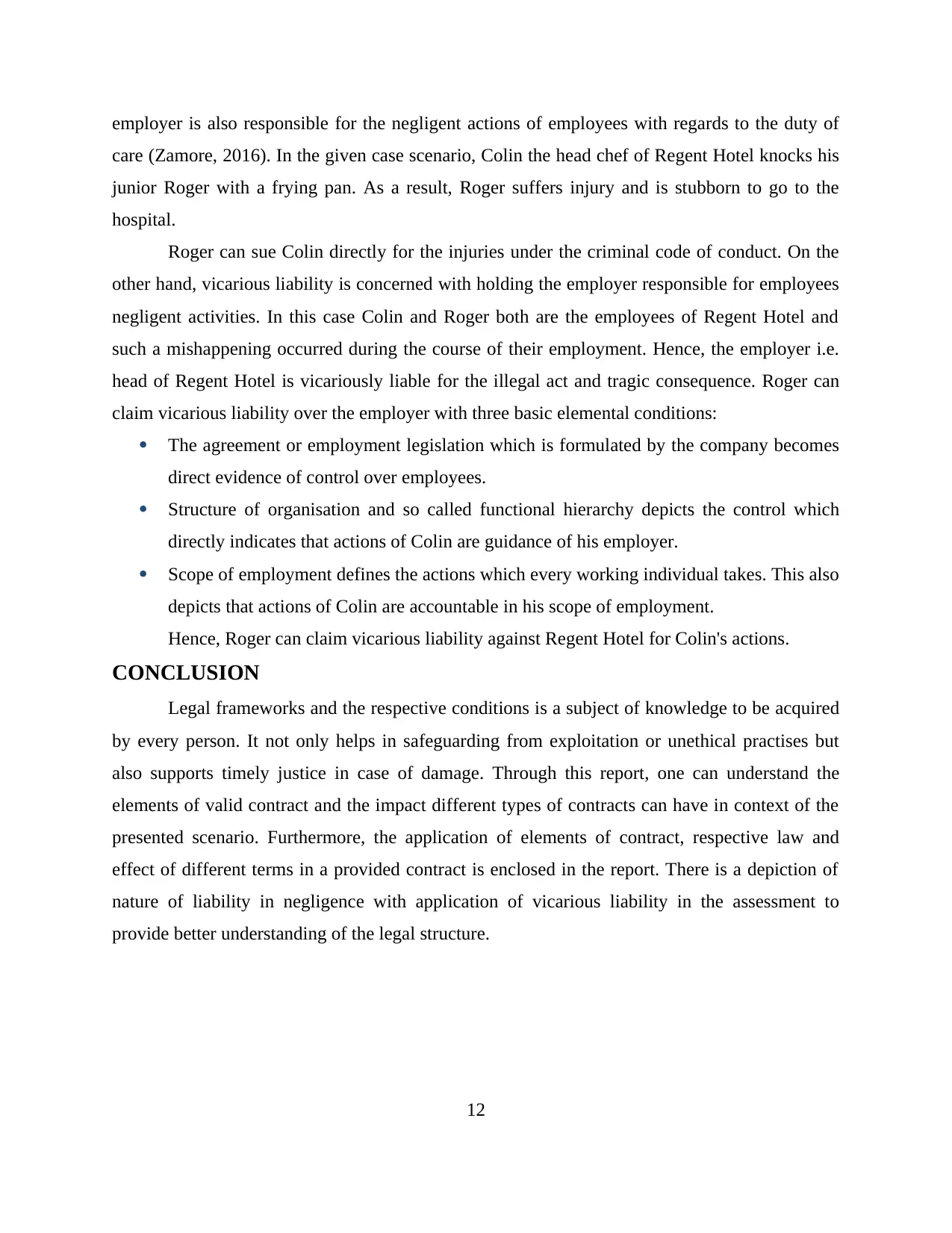
employer is also responsible for the negligent actions of employees with regards to the duty of
care (Zamore, 2016). In the given case scenario, Colin the head chef of Regent Hotel knocks his
junior Roger with a frying pan. As a result, Roger suffers injury and is stubborn to go to the
hospital.
Roger can sue Colin directly for the injuries under the criminal code of conduct. On the
other hand, vicarious liability is concerned with holding the employer responsible for employees
negligent activities. In this case Colin and Roger both are the employees of Regent Hotel and
such a mishappening occurred during the course of their employment. Hence, the employer i.e.
head of Regent Hotel is vicariously liable for the illegal act and tragic consequence. Roger can
claim vicarious liability over the employer with three basic elemental conditions:
The agreement or employment legislation which is formulated by the company becomes
direct evidence of control over employees.
Structure of organisation and so called functional hierarchy depicts the control which
directly indicates that actions of Colin are guidance of his employer.
Scope of employment defines the actions which every working individual takes. This also
depicts that actions of Colin are accountable in his scope of employment.
Hence, Roger can claim vicarious liability against Regent Hotel for Colin's actions.
CONCLUSION
Legal frameworks and the respective conditions is a subject of knowledge to be acquired
by every person. It not only helps in safeguarding from exploitation or unethical practises but
also supports timely justice in case of damage. Through this report, one can understand the
elements of valid contract and the impact different types of contracts can have in context of the
presented scenario. Furthermore, the application of elements of contract, respective law and
effect of different terms in a provided contract is enclosed in the report. There is a depiction of
nature of liability in negligence with application of vicarious liability in the assessment to
provide better understanding of the legal structure.
12
care (Zamore, 2016). In the given case scenario, Colin the head chef of Regent Hotel knocks his
junior Roger with a frying pan. As a result, Roger suffers injury and is stubborn to go to the
hospital.
Roger can sue Colin directly for the injuries under the criminal code of conduct. On the
other hand, vicarious liability is concerned with holding the employer responsible for employees
negligent activities. In this case Colin and Roger both are the employees of Regent Hotel and
such a mishappening occurred during the course of their employment. Hence, the employer i.e.
head of Regent Hotel is vicariously liable for the illegal act and tragic consequence. Roger can
claim vicarious liability over the employer with three basic elemental conditions:
The agreement or employment legislation which is formulated by the company becomes
direct evidence of control over employees.
Structure of organisation and so called functional hierarchy depicts the control which
directly indicates that actions of Colin are guidance of his employer.
Scope of employment defines the actions which every working individual takes. This also
depicts that actions of Colin are accountable in his scope of employment.
Hence, Roger can claim vicarious liability against Regent Hotel for Colin's actions.
CONCLUSION
Legal frameworks and the respective conditions is a subject of knowledge to be acquired
by every person. It not only helps in safeguarding from exploitation or unethical practises but
also supports timely justice in case of damage. Through this report, one can understand the
elements of valid contract and the impact different types of contracts can have in context of the
presented scenario. Furthermore, the application of elements of contract, respective law and
effect of different terms in a provided contract is enclosed in the report. There is a depiction of
nature of liability in negligence with application of vicarious liability in the assessment to
provide better understanding of the legal structure.
12
⊘ This is a preview!⊘
Do you want full access?
Subscribe today to unlock all pages.

Trusted by 1+ million students worldwide
1 out of 14
Related Documents
Your All-in-One AI-Powered Toolkit for Academic Success.
+13062052269
info@desklib.com
Available 24*7 on WhatsApp / Email
![[object Object]](/_next/static/media/star-bottom.7253800d.svg)
Unlock your academic potential
Copyright © 2020–2025 A2Z Services. All Rights Reserved. Developed and managed by ZUCOL.





